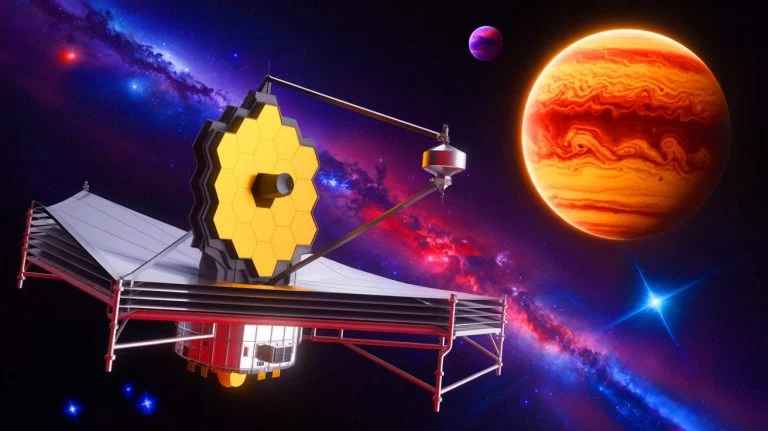| IN A NUTSHELL |
|
The James Webb Space Telescope has provided an unprecedented glimpse into the formation of planetary systems by capturing the first-ever image of a Saturn-like exoplanet. This remarkable achievement, led by a team of scientists under the guidance of a French researcher, marks a significant milestone in space exploration. The exoplanet, named TWA 7b, offers a unique opportunity to study the dynamics and characteristics of young planetary systems. Positioned in a nearby system, TWA 7b showcases the powerful capabilities of the James Webb telescope and highlights the potential for future discoveries in the vast expanse of the universe.
Revolutionizing Exoplanet Observation
The James Webb Space Telescope, a collaborative project involving NASA, the European Space Agency (ESA), and the Canadian Space Agency (CSA), has achieved a groundbreaking milestone in exoplanet research. For the first time, it has directly observed a low-mass exoplanet using its infrared imaging capabilities. This achievement represents a significant scientific and technological advancement. The planet, named TWA 7b, orbits the star TWA 7, located only 111 light-years from Earth. This observation is the first direct image of an extrasolar world captured by the James Webb telescope, an achievement made possible by the coronagraph integrated into the MIRI (Mid-Infrared Instrument).
The exoplanet resides well beyond the average distance between Earth and the Sun, approximately 50 astronomical units, within a young system aged 6.4 million years. This relatively young age results in a higher temperature of around 47°F, making it ideally observable in the mid-infrared spectrum. The planet’s interaction with its environment is particularly intriguing to researchers, as it has been detected within a gap in the debris disk surrounding its star. This observation supports theoretical models suggesting that planets can shape circumstellar disks through gravitational effects, forming gaps or rings.
Dr. Anne-Marie Lagrange, the lead researcher, notes that the infrared source’s position aligns precisely with model predictions for a planet capable of sculpting the observed disk structure. This discovery provides valuable insights into planetary system formation and dynamics.
A New Era in Studying Distant Celestial Bodies
The MIRI coronagraph, developed by a consortium led by France, has played a crucial role in this achievement. By simulating a mini-eclipse, it effectively suppressed the glare of the host star, revealing faint nearby sources. Captured on June 21, 2024, the image unveiled a faint infrared signal, distinct from background galaxies or solar system objects. This observation strongly supports the existence of TWA 7b, confirmed with sophisticated image processing tools capable of extracting and isolating a faint but consistent signal from a cold, low-mass planet.
The “face-on” configuration of the TWA 7 disk, viewed directly from Earth, proved ideal for observing the interaction between the planet and surrounding dust. This achievement demonstrates that James Webb can now directly image worlds similar to those in our solar system, not just massive gas giants. TWA 7b, with its 100 Earth masses, is the least massive exoplanet detected using this technique, lowering the detection threshold for instruments and paving the way for the search for potentially habitable or even Earth-like planets around nearby stars.
Mathilde Malin, a co-author of the study and a researcher at Johns Hopkins University, emphasizes the significance of this advancement, stating that the era of directly imaging planets with masses comparable to those in our solar system has become a reality thanks to Webb’s capabilities.
International Collaboration and French Excellence
The success of this observation is the result of a brilliantly orchestrated collaboration between agencies and laboratories. The ESA played a central role in developing the MIRI instrument within the MIRI European Consortium. France, with its researchers and expertise in optical instrumentation, once again establishes itself as a major player in space exploration. This discovery also opens the door to future research projects, especially the confirmation of a possible “Troyan disk,” a collection of dust trapped in a planet’s orbit. If confirmed, this never-before-observed phenomenon will greatly enhance our understanding of the dynamics of young planetary systems.
TWA 7b unveils a new window into our cosmic origins. The James Webb Space Telescope solidifies its position as the flagship instrument for the next decade of astronomy, offering unprecedented insights into the universe’s mysteries.
The Future of Exoplanet Research
As the James Webb Space Telescope continues to push the boundaries of space exploration, the implications of its discoveries extend far beyond the scientific community. By capturing direct images of exoplanets like TWA 7b, Webb provides a tangible glimpse into worlds beyond our solar system. This achievement raises profound questions about the potential for life on other planets and the formation of planetary systems.
With its advanced capabilities, Webb opens up new avenues for understanding the universe’s complex and dynamic nature. As researchers delve deeper into the mysteries of the cosmos, one question becomes increasingly pertinent: How will the continued exploration of these distant worlds reshape our understanding of our place in the universe?
Did you like it? 4.6/5 (29)





Wow, this is mind-blowing! Could TWA 7b actually host life? 🤯
Great article, but I wonder, how can we be sure the image isn’t just a blur?
Thanks for the update! James Webb never fails to amaze.
Does this mean we might find aliens soon? 👽
Is there any chance this discovery could impact future space missions?
I love space exploration! Keep these amazing discoveries coming! 🚀
How accurate are these infrared images really?
Is TWA 7b similar to any planets in our solar system?
Can this help us find Earth-like planets? 🌍
This is just the beginning! Imagine what we’ll discover next. 😃